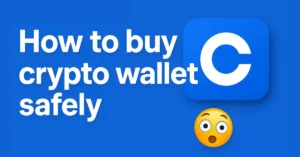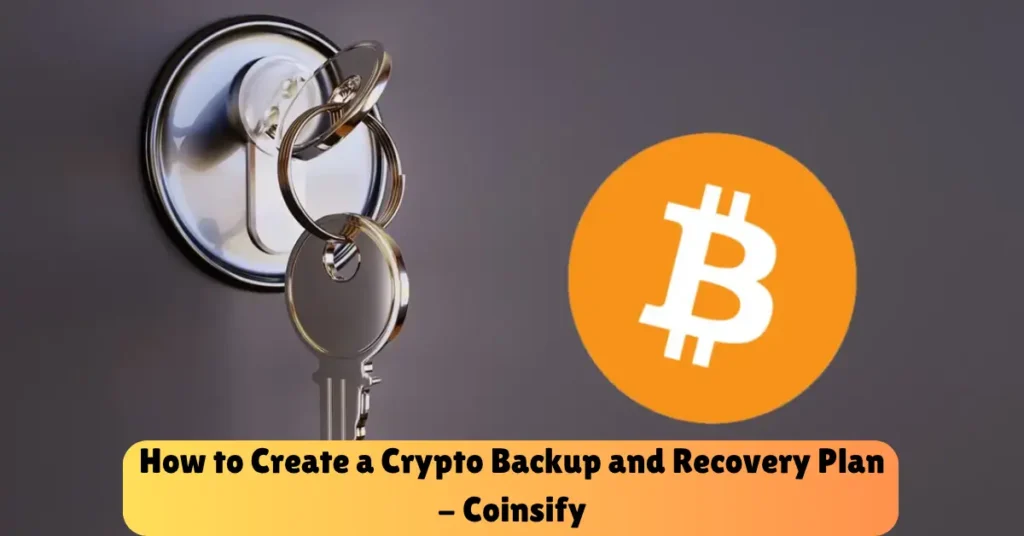How to Create a Crypto Backup and Recovery Plan
Introduction
As cryptocurrencies like Bitcoin and Ethereum become more popular, many people are investing in them for the long term. But while buying and storing crypto is important, there’s one thing many users forget — what happens if you lose access to your wallet? What if your phone breaks, your computer crashes, or you forget your password?
This is where a crypto backup and recovery plan comes in.
Just like you back up your important files or photos, you also need a safe way to back up your crypto. A backup and recovery plan helps you protect your digital money and makes sure you can always get it back if something goes wrong. In this blog, we’ll explain what a crypto backup and recovery plan is, why it matters, and how to create one step-by-step — even if you’re not a tech expert.
Let’s get started!
What is a Crypto Backup and Recovery Plan?
A crypto backup and recovery plan is a personal safety strategy that helps you protect and recover access to your cryptocurrency if something goes wrong, like losing your phone, computer, or wallet.
When you use a crypto wallet (whether it’s on your phone, computer, or a hardware device), you’re given special information like a seed phrase or private key. These are the keys to your crypto. If you lose them, you lose access to your funds, and there’s no way to reset or recover them like a regular password.
That’s why having a backup plan is so important. It means safely storing this sensitive information in more than one secure place, and having a clear plan to recover your assets if your wallet gets lost, stolen, or damaged.
In simple words, a crypto backup and recovery plan is like a safety net for your digital money, so you never lose access, no matter what happens.
Why is It Important?

Creating a crypto backup and recovery plan is not just a good idea — it’s necessary. Here’s why:
There’s No “Forgot Password” Option
- Unlike bank accounts or social media, there’s no customer support team to help you recover lost crypto. If you lose your private keys or seed phrase, your funds are gone forever.
You Are in Full Control (and Fully Responsible)
- Cryptocurrencies give you full ownership of your money, but that also means you’re the only one responsible for keeping it safe. If you don’t back it up, no one else can help you recover it.
Devices Can Fail
- Phones can get lost, computers can crash, and hardware wallets can break. Without a backup, your access to your crypto disappears along with the device.
Protection Against Theft or Hacking
- If your device is stolen or hacked, a good recovery plan ensures you can still access your crypto using your backup.
Planning for the Future
- If something happens to you, your family should be able to recover your crypto. A proper backup and recovery plan can help your loved ones access your assets securely and legally.
In short, a backup plan protects your investment and gives you peace of mind, knowing that no matter what happens, your crypto is safe and recoverable.
Core Components of a Backup Plan
To create a strong and reliable crypto backup and recovery plan, you need to include a few key elements. These are the core parts that make sure your digital assets stay safe and can be recovered at any time.
Seed Phrase Backup
- When you set up a crypto wallet, it gives you a seed phrase (usually 12, 18, or 24 random words).
- This phrase is the master key to your wallet. Anyone with it can access your crypto.
- Write it down on paper or a metal plate — never store it digitally or online.
- Store it in a secure and private location, such as a home safe or a bank locker.
Private Key Backup
- Some wallets also provide private keys for each crypto address.
- Like the seed phrase, these must be backed up securely and kept offline.
- Private keys are more technical, but essential if you use non-standard wallets or manage multiple addresses.
Wallet File Backup
- If you’re using a desktop or software wallet, make sure to back up important files like wallet.dat (for Bitcoin Core) or keystore files (for Ethereum wallets).
- Store these files on encrypted USB drives or external hard drives.
Location Redundancy
- Don’t rely on just one copy or one location.
- Keep multiple backups in different safe places (for example, one at home, one at a trusted family member’s house, and one in a secure deposit box).
- This protects your backups from fire, theft, or natural disasters.
By covering these four components, you build a strong safety net around your cryptocurrency. Even if one backup fails or gets lost, you’ll still have another way to recover your assets.
Best Practices for Recovery Planning
Once you’ve backed up your crypto wallet, the next step is to make sure your recovery plan is safe, practical, and easy to follow. Here are some best practices to help you stay protected:
Use Cold Storage
- Store your seed phrase, private keys, and wallet backups offline (also called cold storage).
- Paper backups, metal backups, and hardware wallets are safer than digital storage because they’re not connected to the internet, making them harder to hack.
Encrypt Digital Backups (If Necessary)
- If you must store backups on your computer or in cloud storage, encrypt them with strong passwords.
- Use trusted encryption tools to prevent unauthorized access — but remember the password, or your backup will be useless.
Create a Recovery Guide
Write a simple, step-by-step guide on how to recover your wallet using your backup.
This is helpful for your future self or for family members who might need to access your crypto if you’re not around.
Include:
- The type of wallet you used
- Where the backup is stored
- Instructions for restoring the wallet
Store in Multiple Locations
- Keep backups in at least two or three different places.
- Use secure and private locations, such as a home safe, bank safety deposit box, or a trusted family member’s home.
- Avoid keeping all backups in the same place to reduce risk from theft, fire, or other disasters.
Update Your Backups
Any time you:
- Create a new wallet
- Add new coins
- Change your wallet setup
- You should update your backup plan.
Regular checks help ensure your backups are still valid and accessible.
Following these best practices gives you more than just safety — it gives you peace of mind, knowing that your crypto can always be recovered if something goes wrong.
Inheritance and Emergency Access
Many people build wealth through cryptocurrency, but few plan for what happens if they become unable to access it, due to illness, accidents, or death. Just like with any other valuable asset, it’s important to include your crypto in your inheritance and emergency plans.
Plan for the Unexpected
- If you’re the only one who knows how to access your wallet, your crypto could be lost forever if something happens to you.
- Make sure a trusted family member or legal representative knows about your backup plan — or at least knows where to find the recovery guide.
Create a Simple Instruction Guide
Prepare a clear, easy-to-understand document that explains:
- What type of wallets do you use
- Where the seed phrase or private keys are stored
- How to access and recover the wallets
- Any passwords or PINs they’ll need (stored securely)
- Keep this guide with you or in a legal document folder.
Use Multi-Signature Wallets (Optional)
- For added safety, you can use a multi-signature wallet that requires approval from more than one person to make transactions.
- This setup can allow you to share access with a trusted person (such as a spouse or lawyer) without giving them full control.
Work with a Lawyer (If Needed)
- If your crypto portfolio is large, it’s smart to speak with a lawyer about including it in your estate planning.
- Make sure your digital assets are legally protected and mentioned in your will.
By planning, you ensure that your digital assets don’t become permanently inaccessible. It’s not just about protecting your crypto — it’s about protecting your loved ones and giving them peace of mind.
What to Avoid

Even with the best intentions, many people make simple mistakes that put their crypto at risk. To keep your backup and recovery plan truly secure, here are some common mistakes you should avoid:
Storing Seed Phrases or Private Keys Digitally (Without Protection)
- Never store your seed phrase or private keys in plain text on your phone, computer, or cloud services like Google Drive or Dropbox.
- If hackers access your device or online accounts, they can steal your crypto instantly.
Taking Screenshots or Photos
- Avoid taking pictures or screenshots of your seed phrase or recovery keys.
- These can be easily hacked, synced to cloud storage, or accidentally shared.
Sharing Recovery Info with Untrusted People
- Don’t tell anyone your seed phrase or private keys unless it’s necessary.
- Only share recovery information with someone you fully trust — and even then, do it safely.
Keeping All Backups in One Place
- Don’t store all your backups in one location, like a single drawer or safe.
- Fire, theft, or flooding could destroy everything. Always create multiple copies and store them in separate secure places.
Using Weak Passwords for Encrypted Files
- If you store wallet files digitally and encrypt them, avoid using weak or easy-to-guess passwords.
- A strong password should be long, complex, and unique.
Forgetting to Update Your Backup
- If you create a new wallet, move funds, or update your setup, make sure your backups reflect those changes.
- Outdated backups can become useless if you later need to recover your wallet.
Avoiding these mistakes can protect you from costly losses and keep your recovery plan reliable. A few extra steps now can save you from a lot of regret later.
Frequently Asked Questions (FAQs)
What is a seed phrase, and why is it important?
A seed phrase is a set of 12, 18, or 24 random words given to you when you create a crypto wallet. It acts like a master password. If you lose access to your wallet, you can use the seed phrase to recover all your crypto. That’s why it’s so important to keep it safe and backed up.
Can I store my seed phrase on my phone or computer?
It’s not recommended. Digital devices can be hacked or infected with viruses. It’s much safer to write your seed phrase on paper or store it on a metal backup, then keep it in a secure place like a safe.
What if I lose my seed phrase or private keys?
If you lose your seed phrase and don’t have any backup, you won’t be able to access your crypto ever again. That’s why making a backup and storing it securely is essential.
Is one backup enough?
No. It’s better to have multiple backups stored in different safe locations. This protects you from things like theft, fire, or accidental loss.
Can I share my backup with someone I trust?
Yes, but be very careful. Only share recovery information with someone you completely trust, like a close family member or legal representative. And make sure they understand how to use it properly.
How often should I update my backup?
Update your backup any time you make changes, like creating a new wallet, adding more funds, or changing devices. Keeping your backup up-to-date ensures it’s ready when you need it.
What is the safest way to store my backup?
The safest way is to:
- Write down your seed phrase or private key on paper or metal (not digital).
- Store it in a locked safe at home or a bank safety deposit box.
- Create multiple copies and store them in different secure places.
What happens to my crypto if something happens to me?
If you don’t plan, your family may not be able to access your crypto. That’s why it’s important to include your backup and recovery instructions in your inheritance plan or will.
Conclusion
Creating a crypto backup and recovery plan is one of the most important steps to keep your digital money safe. By securely backing up your seed phrase, private keys, and wallet files — and storing them in multiple safe places — you protect yourself from losing access to your crypto. Remember, no one can help you recover your funds if you lose this information. So, take the time now to build a clear and reliable backup plan. It will give you peace of mind and ensure your crypto is always safe and recoverable.
Bonus Points
- Use a Hardware Wallet: For extra security, consider using a hardware wallet like Ledger or Trezor. These devices store your private keys offline and reduce hacking risks.
- Consider a Metal Backup: Paper can get damaged or destroyed by water, fire, or time. Using a metal plate to engrave your seed phrase is a durable option for long-term storage.
- Test Your Backup: Before fully relying on your backup, try restoring your wallet on a different device to ensure that the recovery process works smoothly.
- Avoid Public Wi-Fi: To reduce the risk of hacking, avoid using public Wi-Fi networks when accessing or managing your crypto wallets.
- Use Multi-Factor Authentication: For any accounts linked to your crypto activities (email, exchange accounts), enable two-factor authentication (2FA) for extra protection.
- Stay Updated: Keep up with the latest wallet security practices and updates, as the crypto space evolves quickly.
Also read
- What is a Crypto Wallet and How Does It Work? – Coinsify
- 10 Crypto Terms Every Beginner Must Know – Coinsify
- What is Blockchain Technology – Complete Guide – Coinsify
- How to Buy Crypto Safely in 2025 – Complete Guide – Coinsify
- Bitcoin vs Ethereum: Key Differences Explained – Complete Guide
- Ultimate Blockchain Glossary: Learn Blockchain Terms Easily
- How to Buy Bitcoin Safely (Complete Beginner’s Guide)
- Top 10 Crypto Wallets for Beginners (2025 Edition)
- What is Cryptocurrency? A Beginner-Friendly Guide (2025)






